26th August, 2025
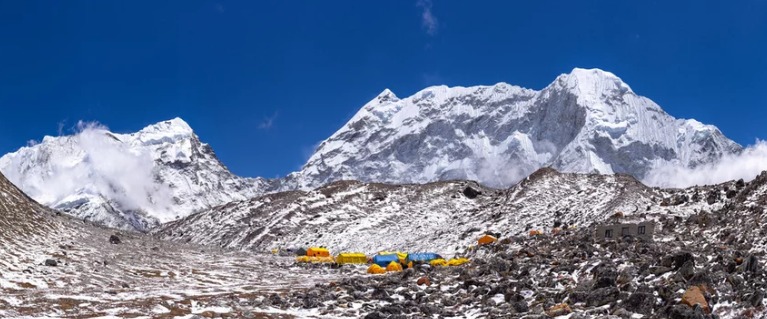
Apr 18, 2024
Island Peak Climbing In November
- I Never Climbed a Mountain: Can I Climb Island Peak In November?
- Packing Lists for Island Peak Climbing
- Tips to Climb Island Peak
- Training for Island Peak
- Why November Is Good to Climb Island Peak
- Island Peak Permit Cost
- Permit, Guide, and Porter for Island Peak
- How Much Does it Cost to Climb Island Peak
- Altitude Sickness with Acclimatization
- Island Peak Climbing Weather in November
- Highlights of Island Peak Climbing in November
- How Difficult is Climbing Island Peak? Can We Do Everest Base Camp with Island Peak?
- Conclusion
- Island Peak Climbing Packages
November presents a captivating opportunity for climbers seeking to conquer Island Peak, a prominent trekking peak in the Everest region of Nepal. Known locally as Imja Tse, this majestic peak stands at 6,189 meters (20,305 feet) and offers a thrilling blend of trekking and basic mountaineering challenges amidst stunning Himalayan landscapes.
One of the defining features of Island Peak climbing in November is the favorable weather conditions. As autumn transitions into early winter, the skies over the Everest region are typically clear and stable. This provides climbers with optimal visibility and breathtaking views of the surrounding peaks, including Everest, Lhotse, Nuptse, and Ama Dablam. The crisp, cool air enhances the clarity of these panoramic vistas, creating a surreal backdrop for the ascent.
The temperature in November at lower altitudes ranges from 5 to 15°C (41 to 59°F), gradually decreasing as climbers ascend higher. While nights and early mornings can be chilly, especially at higher camps, the moderate daytime temperatures make trekking and climbing comfortable and enjoyable.
November also marks the end of the monsoon season, ensuring minimal precipitation and reducing the risk of encountering heavy snowfall or rain. The trails are relatively dry and stable, making navigation easier and safer for climbers. This stable weather window allows for a smoother ascent and descent, enhancing the overall climbing experience.
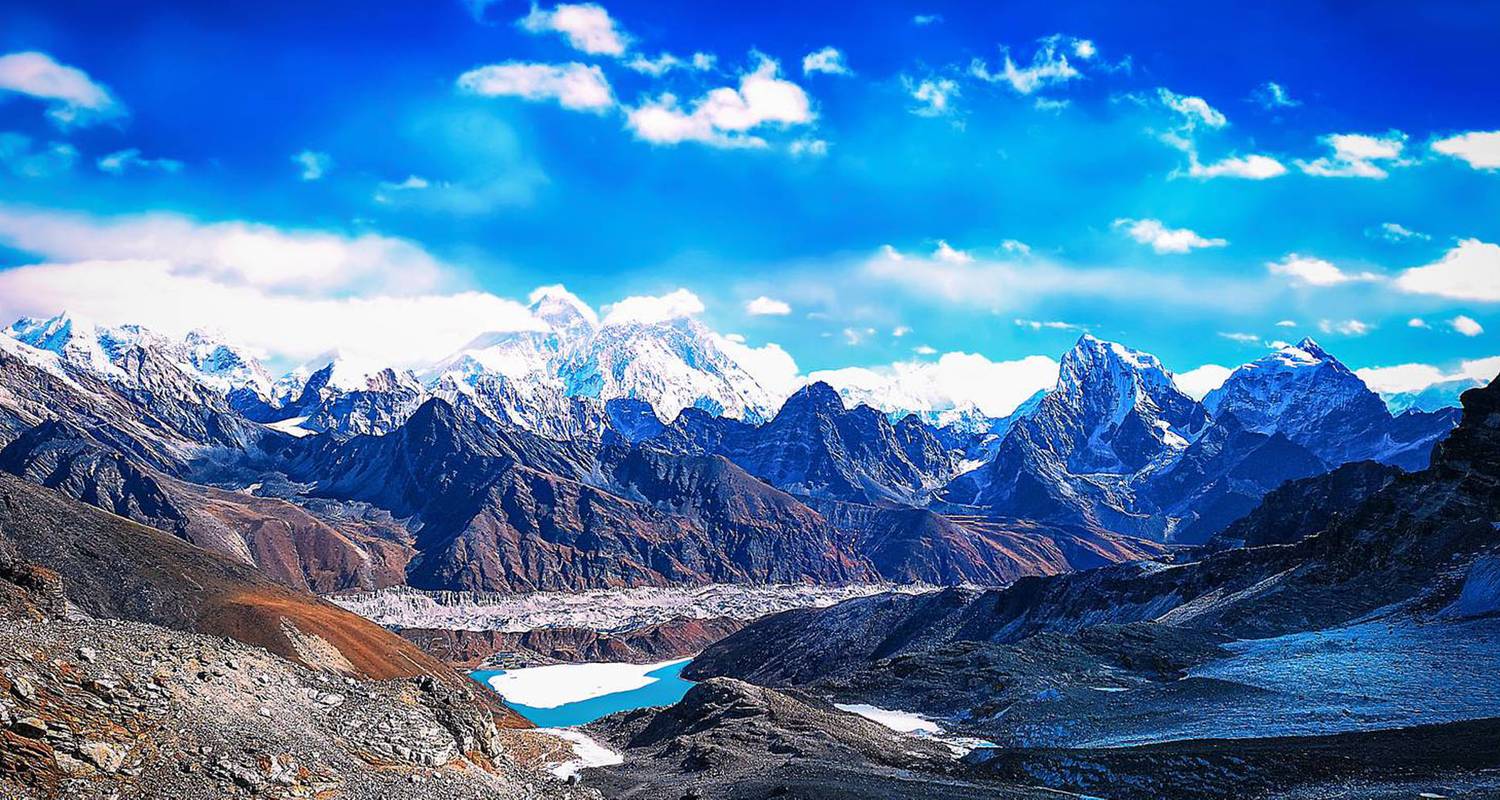
Everest Three High Pass Trek with Island Peak Climbing
The Everest Three High Pass Trek with Island Peak Climbing is an exhilarating and challenging adventure that takes you through the stunning landscapes of the Everest region in Nepal. This 23-25...
Climbers embarking on Island Peak in November typically follow a route that starts with a scenic trek through the Khumbu Valley. Passing through vibrant Sherpa villages like Namche Bazaar and Tengboche, climbers immerse themselves in the local culture and hospitality, adding a cultural dimension to their adventure.
As climbers approach Island Peak Base Camp, located at approximately 5,200 meters (17,060 feet), they undergo necessary acclimatization. This involves rest days and short hikes to higher elevations, preparing their bodies for the altitude challenges ahead.
The ascent from Base Camp to the summit involves negotiating glacial terrain and a final steep snow and ice slope. With the guidance of experienced Sherpa guides, climbers tackle technical sections using crampons, ice axes, and ropes, culminating in the rewarding experience of standing atop Island Peak's summit.
Overall, Island Peak climbing in November offers an exhilarating blend of natural beauty, cultural immersion, and personal achievement. It's a journey that challenges climbers physically and mentally while rewarding them with unforgettable memories and unparalleled views of the Himalayas. For adventurers seeking an iconic Himalayan peak experience in a favorable weather window, November presents an ideal opportunity to conquer Island Peak and embrace the spirit of mountaineering in Nepal's breathtaking Khumbu region.
I Never Climbed a Mountain: Can I Climb Island Peak In November?
Climbing Island Peak in November is feasible for adventurers without prior mountain climbing experience, provided they undergo proper training and preparation. November offers favorable weather conditions in the Everest region, with clear skies and stable temperatures conducive to climbing. While Island Peak (6,189 meters or 20,305 feet) involves basic mountaineering skills like using crampons and ice axes, these can be learned during preparatory training.
Physical fitness is crucial, involving cardiovascular exercises, strength training, and altitude acclimatization to prevent altitude sickness. Hiring experienced guides familiar with the terrain and weather patterns enhances safety and support throughout the ascent. With determination and guidance, even novice climbers can successfully summit Island Peak, enjoying panoramic views of Himalayan giants like Everest, Lhotse, and Ama Dablam from the peak.

ISLAND PEAK CLIMBING
Sherpa Expedition & Trekking (Est.1977) are pleased to announce FOR ADVENTURERS the most awesome, exhilarating & unforgettable climbing and treks on offer anywhere today!...
Packing Lists for Island Peak Climbing
Packing efficiently for Island Peak climbing in November is essential for comfort and safety amidst changing Himalayan weather. Key items include:
- Clothing Layers: Moisture-wicking base layers, insulated mid-layers, waterproof and windproof outer shells, gloves, hats, and durable trekking pants.
- Footwear: Well-broken-in, waterproof trekking boots with ankle support, and insulated mountaineering boots for crampon use.
- Climbing Gear: Harness, helmet, crampons, ice axe, ropes, and necessary safety equipment.
- Sleeping Gear: Four-season sleeping bag suitable for cold temperatures and a lightweight sleeping mat.
- Personal Items: Sunscreen, lip balm, sunglasses, headlamp with spare batteries, trekking poles, and hydration system.
- Medical Supplies: Basic first aid kit, altitude sickness medications, and personal medications.
Consult with guides or trekking agencies for specific recommendations based on current conditions and itinerary.
Tips to Climb Island Peak
Successfully climbing Island Peak in November requires thorough preparation and adherence to safety guidelines:
- Physical Preparation: Build cardiovascular endurance, strength, and stamina through aerobic exercises, strength training, and long hikes with a loaded backpack.
- Altitude Acclimatization: Ascend gradually, incorporating rest days to adjust to high altitudes and stay hydrated.
- Basic Mountaineering Skills: Practice using crampons, ice axes, and rope handling techniques before the expedition.
- Guide Support: Hire experienced guides who provide route navigation, safety protocols, and technical assistance during the climb.
- Weather Monitoring: Stay informed about weather forecasts and adjust climbing plans accordingly to ensure safety.
- Packing Wisely: Carry essential gear and clothing layers suitable for varying Himalayan weather conditions.
By preparing meticulously and respecting the mountain environment, climbers enhance their chances of a safe and rewarding ascent of Island Peak.
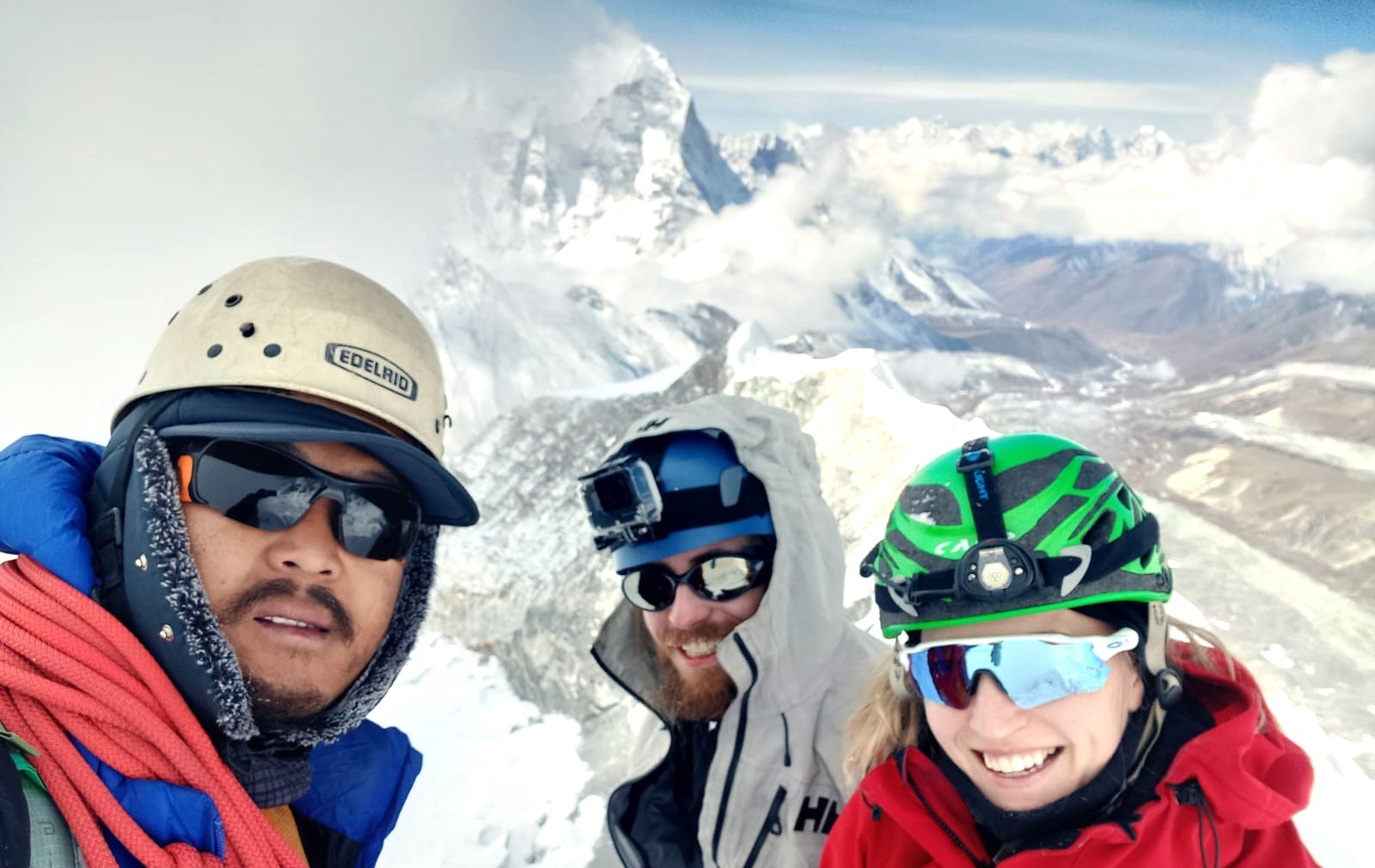
ISLAND PEAK EXPEDITION 15 DAYS
Island Peak, also known as Imja Tse, is a popular peak located in the Khumbu region of Nepal. This peak is a part of the Himalayas and stands tall at a height of 6,189 meters above sea level. Island P...
Training for Island Peak
Training for Island Peak in November focuses on building physical fitness, endurance, and acclimatization:
- Cardiovascular Fitness: Engage in aerobic exercises like hiking, running, and cycling to enhance endurance and stamina.
- Strength Training: Develop leg and core strength with exercises such as squats, lunges, and planks. Include upper body workouts for climbing movements.
- Altitude Simulation: If possible, simulate high-altitude conditions through altitude training or hiking at higher elevations.
- Flexibility and Balance: Practice yoga or stretching exercises to improve flexibility, balance, and injury prevention.
- Practicing Climbing Skills: Learn basic mountaineering techniques such as using crampons, ice axes, and rope handling under guidance.
Training should be gradual and tailored to individual fitness levels to ensure readiness for the physical demands of Island Peak climbing.
Why November Is Good to Climb Island Peak
November is an excellent month for climbing Island Peak due to favorable weather conditions in the Everest region. As autumn transitions into early winter, climbers benefit from:
- Clear Skies: Typically, November offers clear, stable weather with minimal precipitation, ensuring excellent visibility and stunning views of the surrounding Himalayan peaks.
- Moderate Temperatures: Daytime temperatures at lower altitudes range comfortably, making trekking and climbing enjoyable. While nights are cooler, proper clothing and gear preparation mitigate the cold.
- Minimal Crowds: November sees fewer climbers compared to peak seasons like spring, offering a quieter and more serene climbing experience.
- Optimal Climbing Conditions: Dry trails and stable weather conditions facilitate safer and more manageable ascents, reducing risks associated with monsoon rains or winter snowfall.
- Cultural Experience: Trekking through vibrant Sherpa villages and enjoying the hospitality of local communities adds a cultural dimension to the expedition.
Overall, November combines ideal weather, scenic beauty, and cultural immersion, making it an optimal time to embark on the exhilarating journey of climbing Island Peak in Nepal's Himalayas.
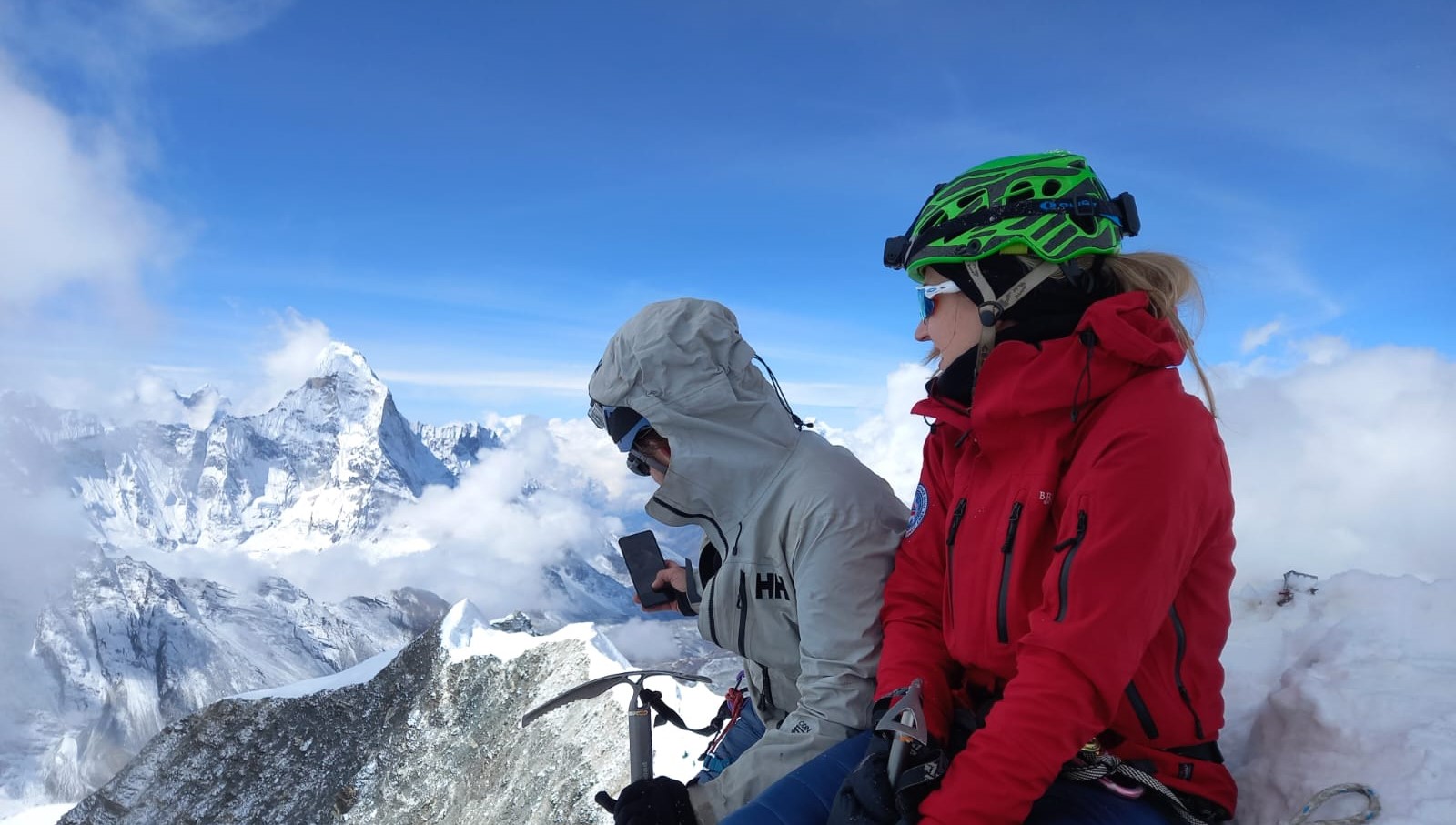
ISLAND PEAK EXPEDITION 14 DAYS
Island Peak Expedition is a 14-day adventure tour that takes you to the heart of the Himalayas, where you can witness the beauty of the mountains, valleys, and glaciers. Island Peak, also known as Imj...
Island Peak Permit Cost
Obtaining permits for climbing Island Peak involves several fees regulated by the Nepalese government to manage mountaineering activities in the Everest region. As of the latest information, the permit costs typically include:
- Island Peak Climbing Permit: This permit varies between USD 250 to USD 500 per person, depending on the season and specific regulations set by the government.
- Sagarmatha National Park Entry Permit: Essential for accessing the Everest region, costing approximately USD 30 per person.
These permits must be arranged through a registered trekking agency or expedition organizer, as independent applications are not accepted. The agency handles all necessary paperwork and logistics, ensuring compliance with local regulations and providing support throughout the expedition.
Understanding the permit costs and requirements beforehand helps climbers budget effectively and ensures a smooth administrative process, allowing them to focus on preparing for the physical and mental challenges of climbing Island Peak.
Permit, Guide, and Porter for Island Peak
For a successful climb of Island Peak, climbers typically engage the services of experienced guides and, optionally, porters to support the expedition. The costs for permits, guides, and porters vary depending on factors such as the trekking agency, season, and specific services included:
- Permits: Include fees for the Island Peak climbing permit (USD 250 to USD 500) and the Sagarmatha National Park entry permit (USD 30).
- Guide Fees: Experienced guides provide route navigation, safety support, and technical assistance. Guide fees range from USD 20 to USD 50 per day, depending on experience and services offered.
- Porter Fees: Porters carry equipment and supplies during the trek, easing the physical burden on climbers. Porter fees are typically USD 15 to USD 25 per day.
Trekking agencies often offer package deals that include permits, guide services, and sometimes porter support. These packages streamline logistics and ensure compliance with local regulations, allowing climbers to focus on the ascent and enjoy the journey safely.
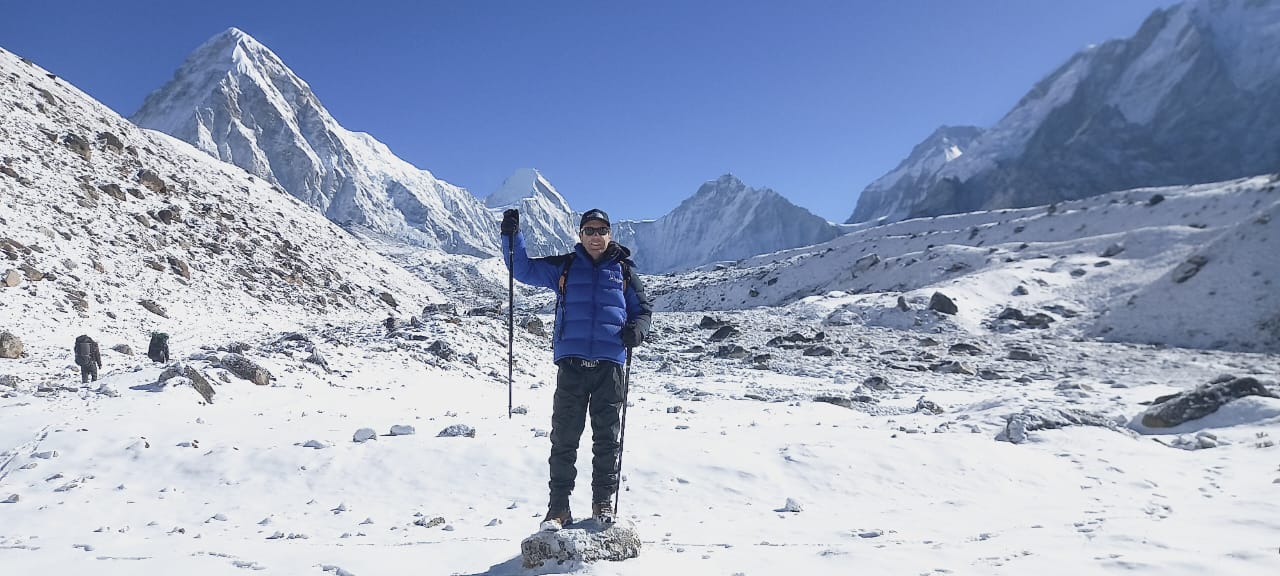
ISLAND AND LOBUCHE PEAK CLIMBING
Lobuche and Island Peak combo climbing expedition is a thrilling adventure that offers a unique opportunity to conquer two popular peaks in the Everest region of Nepal. Lobuche Peak (6,119m) and Islan...
How Much Does it Cost to Climb Island Peak
The total cost of climbing Island Peak varies depending on several factors, including permits, guide and porter fees, equipment rental, accommodation, meals, and miscellaneous expenses:
- Permits: USD 280 to USD 530 (including climbing permit and national park entry).
- Guide and Porter Fees: Approximately USD 35 to USD 75 per day, depending on experience and services provided.
- Equipment Rental: Costs vary but can add several hundred dollars for renting climbing gear like crampons, ice axes, and harnesses.
- Accommodation and Meals: Budget around USD 25 to USD 50 per day for lodging in teahouses and meals along the trekking route.
- Miscellaneous Expenses: Include travel insurance, international airfare to Nepal, visa fees, tips, and personal expenses.
Overall, climbers should budget between USD 3,000 to USD 6,000 per person for a standard 16- to 20-day expedition, depending on individual preferences and the level of comfort desired during the climb.

ISLAND PEAK SUMMIT RETURN BY HELICOPTER
Many of us only dream of standing on a tall peak looking down on the world. This is a great climb that will satisfy this desire. Island Peak, also referred to as Imja Tse, is a 6187-meter high peak in...
Altitude Sickness with Acclimatization
Altitude sickness, also known as acute mountain sickness (AMS), is a potential concern when climbing Island Peak due to the high altitudes involved. AMS occurs when the body fails to acclimatize adequately to reduced oxygen levels at higher elevations, typically above 2,500 meters (8,200 feet).
To mitigate altitude sickness, climbers should adhere to the following acclimatization guidelines:
- Gradual Ascent: Ascend slowly, allowing time for the body to adjust to increasing altitudes. It's essential to schedule rest days and ascend no more than 300-500 meters per day above 3,000 meters (10,000 feet).
- Hydration and Nutrition: Drink plenty of fluids and maintain a balanced diet to support physical exertion and adaptation to altitude.
- Medication: Consider medications like acetazolamide (Diamox) to aid acclimatization, under the guidance of a healthcare professional.
- Recognizing Symptoms: Be aware of early signs of altitude sickness, including headaches, nausea, dizziness, and fatigue. Communicate any concerns to guides or fellow climbers promptly.
- Descend if Necessary: If symptoms worsen despite precautions, descend to a lower altitude immediately. Prompt action can prevent serious complications such as high-altitude pulmonary edema (HAPE) or cerebral edema.
Proper acclimatization, physical fitness, and awareness of altitude sickness symptoms are essential for a safe and enjoyable climb of Island Peak, ensuring climbers can reach the summit and return safely to lower altitudes.
Island Peak Climbing Weather in November
November presents favorable weather conditions for climbing Island Peak in the Everest region of Nepal. As autumn transitions into early winter, climbers can expect clear skies and stable weather patterns. Daytime temperatures at lower altitudes range from 5 to 15°C (41 to 59°F), providing comfortable trekking conditions. However, temperatures drop significantly at higher elevations, necessitating appropriate clothing and gear for cold conditions, especially during early mornings and nights.
Precipitation is minimal in November, reducing the likelihood of rain or snowfall along the trekking route and on the mountain itself. This dry weather enhances trail stability and visibility, offering stunning panoramic views of Everest, Lhotse, Nuptse, and other Himalayan peaks from Island Peak's summit. Climbers can enjoy crisp air and breathtaking vistas amidst a serene mountain environment, making November an ideal month for this Himalayan adventure.
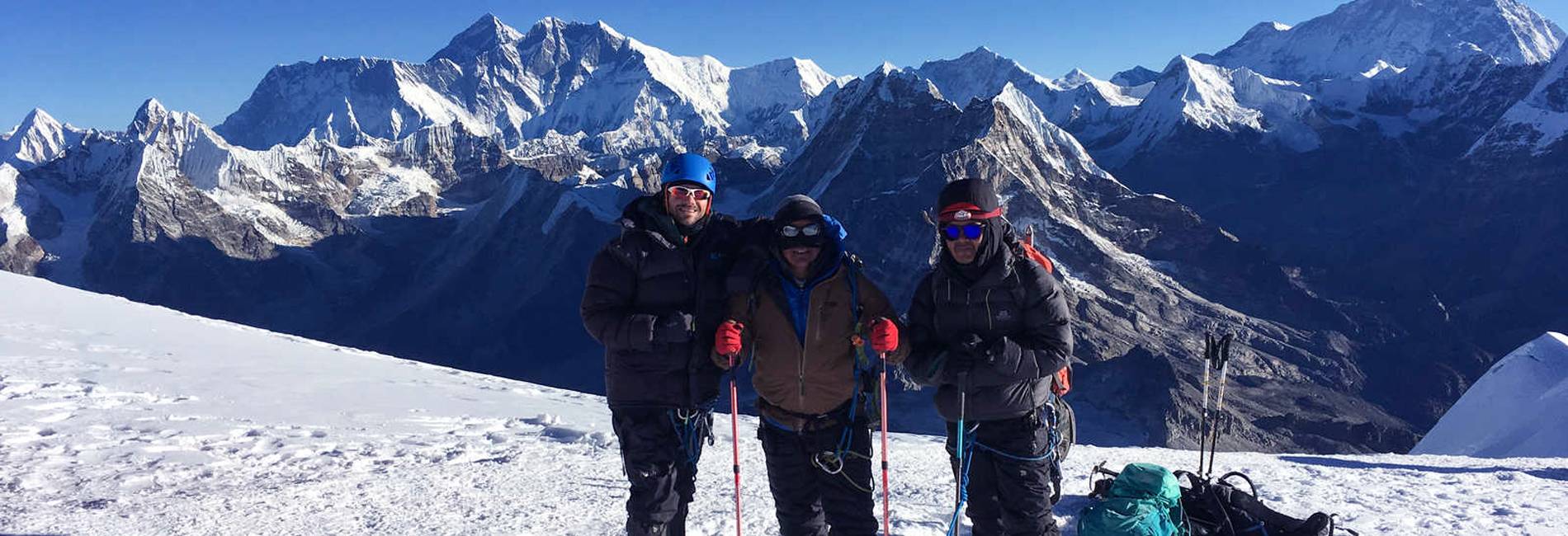
MERA PEAK CLIMBING
Mera Peak Climbing is an exhilarating adventure in Nepal that gives you an opportunity to reach the summit of Mera Peak at more than 6400m above sea level. Actually, it is the highest climbing (w...
Highlights of Island Peak Climbing in November
Climbing Island Peak in November offers several highlights for adventurers seeking a challenging yet rewarding mountaineering experience:
- Optimal Weather: Clear skies and stable weather conditions provide excellent visibility and panoramic views of the Everest region's iconic peaks.
- Scenic Beauty: Trekking through vibrant Sherpa villages like Namche Bazaar and Tengboche, adorned with prayer flags and monasteries, adds cultural immersion to the journey.
- Technical Challenge: Island Peak (6,189 meters or 20,305 feet) involves basic mountaineering skills such as using crampons and ice axes. The ascent includes negotiating glacial terrain and a final steep snow and ice slope to the summit.
- Cultural Experience: Interacting with local Sherpa communities, learning about their traditions, and staying in teahouses along the trekking route enriches the climbing experience.
- Personal Achievement: Summiting Island Peak rewards climbers with a sense of accomplishment and stunning 360-degree views of the Himalayas, including the majestic Everest.
Overall, November combines ideal weather, breathtaking scenery, and cultural exploration, making it a memorable time to conquer Island Peak and immerse oneself in the beauty of the Everest region.

MERA PEAK CLIMBING 17 DAYS
This is an excellent opportunity to climb Nepal’s highest peak without having to obtain a permit (6,476m/21,190ft). From the summit, you will have stunning views of several 8000m plus peaks, such as E...
How Difficult is Climbing Island Peak? Can We Do Everest Base Camp with Island Peak?
Climbing Island Peak is considered moderately difficult and suitable for climbers with basic mountaineering experience. While prior climbing experience is beneficial, many adventurers undertake Island Peak as their first Himalayan peak climb. The ascent involves technical sections like crossing glaciers, using crampons, and ascending a steep snow and ice slope to the summit. With proper training, physical fitness, and acclimatization, climbers can successfully summit Island Peak under the guidance of experienced Sherpa guides.
Combining Everest Base Camp trek with Island Peak climbing is a popular itinerary choice. The journey begins with a scenic trek to Everest Base Camp, immersing climbers in the world's highest mountain's legendary surroundings. After reaching Everest Base Camp, climbers continue to Island Peak Base Camp, where they undergo acclimatization and prepare for the ascent. This combined adventure allows climbers to experience both the iconic base camp and the exhilarating challenge of summiting a Himalayan peak in a single expedition.
Conclusion
Climbing Island Peak in November offers a thrilling adventure amidst favorable weather conditions, stunning landscapes, and cultural immersion in the Everest region of Nepal. With clear skies and stable temperatures, climbers enjoy optimal visibility of Himalayan giants like Everest and Lhotse. The journey combines technical mountaineering challenges with the rich cultural experience of trekking through Sherpa villages and staying in teahouses along the route.
While Island Peak poses moderate difficulty, climbers with determination, proper training, and the guidance of experienced guides can successfully summit this iconic peak. The option to combine Everest Base Camp trek with Island Peak climbing enhances the adventure, providing a comprehensive Himalayan experience in one expedition.
Overall, November stands out as an ideal time for Island Peak climbing, offering adventurers the opportunity to conquer a Himalayan peak amidst breathtaking scenery and cultural diversity, creating memories that last a lifetime.
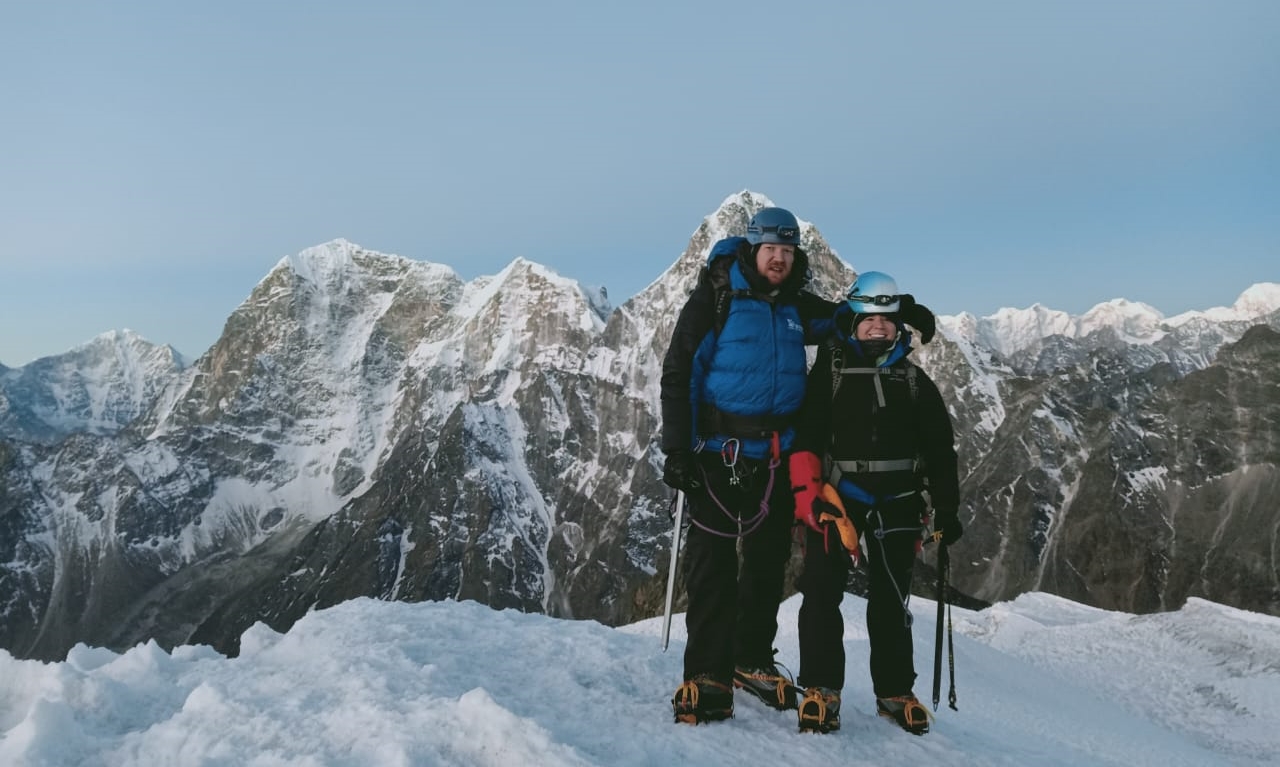
LOBUCHE PEAK CLIMBING
Lobuche East (6,119m/20,075ft), set in Nepal's stunning Khumbu on the Nepalese side of Everest.The best time to go trekking in Nepal is in Autumn (September-November) and in...
Island Peak Climbing Packages
Island Peak Summit Return By Helicopter
Island Peak Expedition 14 Days
Island Peak Expedition 15 Days
Everest Three Pass with Island Peak Climbing
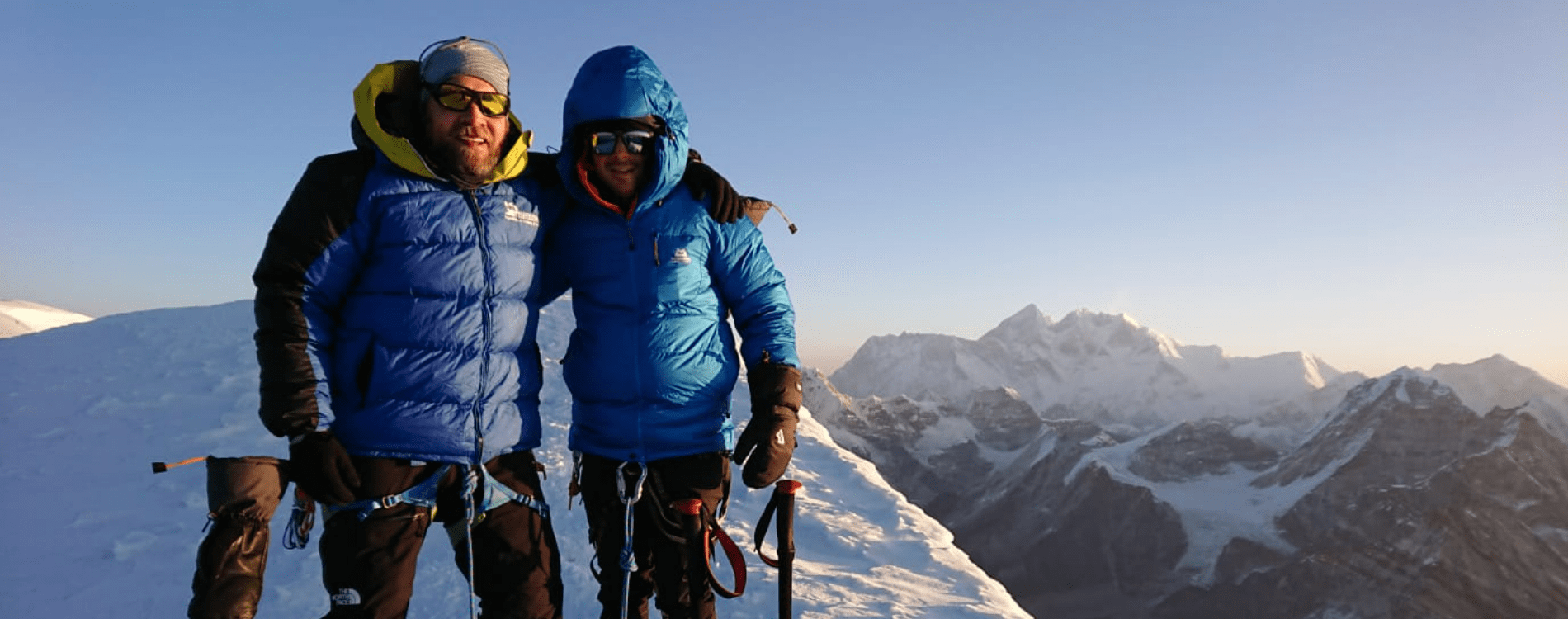
MERA PEAK SUMMIT RETURN BY HELICOPTER
Mera Peak Climbing Just in 12 Days Return By Helicopter to Lukla and flight back Kathmandu.This is an excellent opportunity to climb Nepal’s highest peak without having to obtain a permit (6,476m/21,1...
Any Questions? Let Us Know.
Recent Posts
17th June, 2025


















